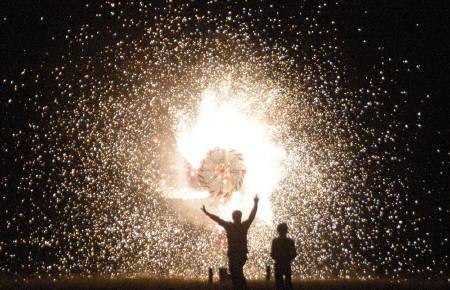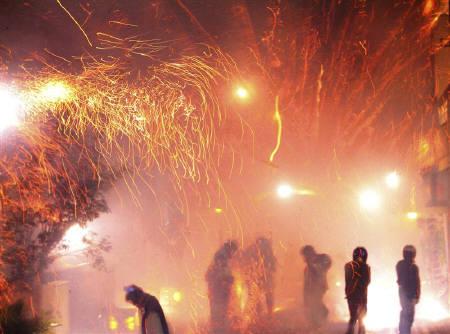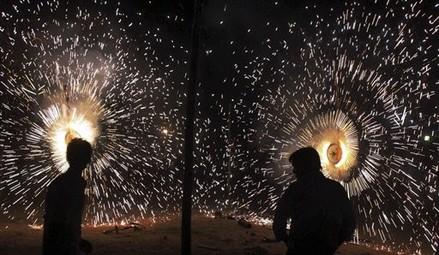T E Narasimhan in Chennai
From burying its stigma as an exploiter of children to implementing better safety procedures, this industry is booming at a 20 per cent growth rate.
The Sivakasi of today is not the Sivakasi of yesteryear. Three years ago, the name 'Sivakasi' would conjure up images of grimy sweatshops and children working feverishly to meet the production quotas for Diwali (or Deepavali, as it is pronounced in the South).
Incidents of entire production facilities blowing up and injuring, even killing, children and adults were not uncommon. .
Today, it is a largely different scene.
The town of Sivakasi - situated some 650kms away from Chennai and spanning just 7.57 kilometres - is the unofficial home of the Rs 1,000 crore (Rs 10 billion) firecracker industry in India.
...
The changing face of Sivakasi
Image: Business has gone through its own evolution.Yet, the town - spotless and sedate - doesn't house any of the factories or units.
Some 600 units directly employing two lakh people lie on the outskirts of town, and can even be found 40 kilometres away.
The big producers have cottages set amidst a lush, forest landscape, with four people to a unit, and each unit spaced 200 metres apart.
Today, instead of employing children, many of these companies take care of those belonging to their employees, constructing creches for them and feeding the babies and toddlers state stipulated quotas of milk and biscuits.
Still, it's not just the employee landscape that has changed - business has also gone through its own evolution.
...
The changing face of Sivakasi
Image: Diwali accounts for 60-65 per cent of business.For one thing, rumours of the industry on the verge of collapse are spurious.
In fact, revenues have shot up 15-20 per cent, largely because the India of today has begun to consume crackers all year round, and not just on Diwali.
Now, weddings, festivals, corporate celebrations or even elections have lit up the sales books of cracker makers, says A P Selvarajan, managing director, Sri Kaliswari Fireworks, the second largest firework company which owns the 'Cock' brand.
Diwali is important but accounts for only 60-65 per cent of total business, while the marriage season accounts for about 25 per cent.
...
The changing face of Sivakasi
Image: The industry is facing a huge labour shortage.The recent World Cup was a bonus, clocking Rs 150 crore (Rs 1.5 billion) for the industry, and even the local municipality election results recently brought it Rs 2 crore (Rs 20 million) of business in a single day.
So much so, that the industry is just not able to satiate the total appetite for firecrackers.
"We can only supply 55-60 per cent of the demand," added Selvarajan.
The main dilemma: Not competition from the Chinese as widely thought - Indian laws do not allow the import and sale of explosives in India - but instead a huge labour shortage.
...
The changing face of Sivakasi
Image: The industry has now started adopting mechanisation.The literacy rate in Sivakasi has been improving in the last three years. Number of schools has increased to 27 (of which eight came up in the last two years) including eight engineering and arts colleges as well as seven polytechnic and ITI institutes.
Consequently, the last thing the new aspirational generation of graduates wants to do is work in the firecracker industry.
So, in order to combat a labour shortage, the industry has now started adopting mechanisation.
For instance, says Selvarajan, the process of chemical mixing has become automated.
Kaliswari Fireworks has got a Rs 2 crore (Rs 20 million) sanction from the Industry Resource Department in the Centre, to continue the process of adopting new automation techniques.
...
The changing face of Sivakasi
Image: Logistics cost have shot up."We are looking at automating filling operations, packaging and drying activities," said Selvarajan.
The company has also tied-up with various private and public institutes to carry out research activities.
For instance, to take up drying activities the company has installed a drier-based on solar energy.
"Currently it takes 2-3 hours to dry a cracker, on a manual basis. Now with the solar dryer it can be done in 45 minutes," says Selvarajan.
Still, problems remain. Earlier, workers were employed within five kilometres of the factory.
Now, units are bringing workers from 50 kilometres away. Logistics cost have therefore shot up.
And the number of units has also gone up to 650 from 300, said representatives from the industry.
...
The changing face of Sivakasi
Image: A worker in a factory earns Rs 120 a day.If this was not enough, District Revenue Officers have given license to another 80-100 small scale units.
A worker in a factory earns Rs 120 a day, going up to Rs 150 - a 20 per cent increase from a year or two ago.
Raw material costs are up by 20-25 per cent, adding to industry woes. Consequently, cracker makers have been forced to increase prices by 10-20 per cent.
You would think that despite these hurdles, the industry is perfectly poised to take advantage of the booming 30,000 crore (Rs 300 billion) global market for fireworks.
...
The changing face of Sivakasi
Image: Exports have been tightly regulated.Unfortunately, the war in Sri Lanka put a stop to that. Earlier, units from Sivakasi used to send fireworks to foreign countries via the Tuticorin (Tamil Nadu) and Colombo ports.
In the last three years exports have been tightly regulated, and the government has said that export from Sivakasi can happen only through the military port in Mumbai.
Another problem: Fireworks were brought under the 'hazardous cargo' category in India, hence the port authorities' refusal to ship them.
However, in China, which is slaking much of the world's thirst for fireworks, crackers are filed under the normal category and declared as 'toys'.
...
The changing face of Sivakasi
Image: The industry is unable to meet the stringent requirements of foreign countries.But it's not just government decrees that are strangling export possibilities - the industry is just not up to mark in meeting the stringent requirements of foreign countries.
"Overseas customers have their own specifications starting from size, sound, etc. They do not accept whatever we manufacture. There are also a number of checkpoints making the process of exporting samples a cumbersome and costly affair.
"And once the samples are approved the final shipment again has to go through testing, then packaging certification and customs verification," says Selvarajan.
One company has managed to by-pass these problems by engineering a canny move: Standard Fireworks has started production in China for the export market by joining hands with China's Liuyang Phoenix Fireworks.
...
The changing face of Sivakasi
Image: The industry has to figure out how to get costs down.Standard Fireworks has two factories producing 25 crore (Rs 250 million) worth of fireworks each which they sell to the US, Europe, Malaysia and Japan amongst others.
"It is not only that regulation alone is the reason for us to set up base in China. The two major factors are connectivity and cost. Cost-wise Chinese products are 100 per cent cheaper than Indian products," says Director Rajasingh Chelladhurai.
The company, which makes more than 500 varieties of fireworks, has 37 factories and employs about 10,000 people.
But not everyone can be a Standard Fireworks and the industry still has to figure out how to get costs down and access markets abroad in order to secure their future.
...
The changing face of Sivakasi
Image: Deaths due to accidents have also fallen.But this much is clear. Child labour, according to NGOs like Seeknews which rescued around 1,200 children from these factories, doesn't exist.
Regulations are very stringent - if a child is found in a factory, the premises are promptly sealed, the owner sent to jail and made to pay for the child's education.
Thanks to strict safety norms, deaths due to accidents have also plummeted - from 43 between July and August of 2009 alone, to 15 last year, to six this year.
That's good stuff for an industry with a bad rap.













article